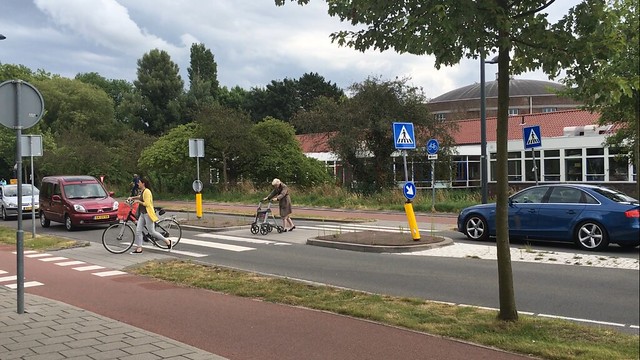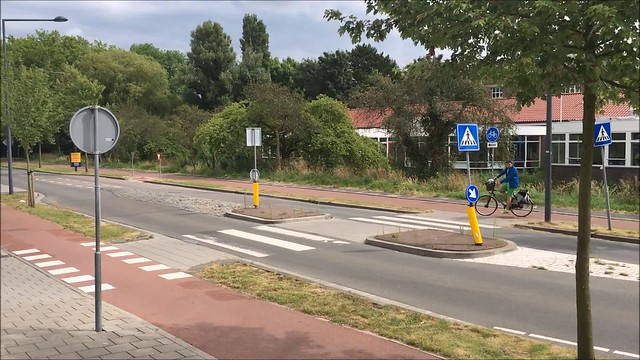Crossing Islands with Horizontal Deflection
Focus Location: Ruys de Beerenbroukstraat
Group Members: Kristen Braley and Sarah Fayerweather
In relation to the objectives of systematic safety, the main objectives of crossing islands are to provide a safer crossing for pedestrians and to slow oncoming car traffic. Together, these two aspects can turn busy roadways into cross-able streets for even the most vulnerable of pedestrians. Crossing islands and their objectives support the concepts of systematic safety in that they prevent pedestrian errors that often result from crossing more than one lane of traffic; even if an error is made, by enforcing the local speed limit with horizontal deflection, the injuries will be far less substantial than if the car had not been slowed. Crossing islands are functional as they are located in places of commerce and living where pedestrians are likely to be out walking or biking and where speed control is necessary to keep motorists from putting pedestrians in danger with high speeds. Crossing islands are easily recognizable and self explanatory because the horizontal deflection intuitively tells drivers to slow down for the curving road and to look out for someone walking across the zebra stripes. Looking from above, it can be seen that the horizontal deflection that crossing islands create is enough of an obstacle to make cars slow down so that they may safely maneuver around the manipulated lane. The curved diversion added is not a feature that can reinforce the speed limit alone, but when used every 250 ft or so, it can slow the cars down along the whole road. The island allows for pedestrians to cross oncoming traffic one direction and one lane at a time instead of having to wait for both lanes to be clear and safe before crossing the entire stretch of the road.
Elderly woman utilizing crossing island to make her way to the market across the street.
Overview map of Ruys de Beerenbroukstraat.
For Ruys de Beerrenbroukstraat, the crossing island is an appropriate feature to add in this urban environment. In particular, the horizontal deflection in this road reduces the speed of traffic to the target limit of 40 km/hr, or 25 mph, while simultaneously improving the visibility of pedestrians crossing the road to the oncoming cars with the help of signs and often times, raised crossings. For pedestrians, by providing the refuge area users can focus on crossing the first lane of traffic, possibly one that quickly comes from behind the bend, before taking on the next lane coming in the opposite direction. On the road there is commercial space, dominated by an Albert Heijn, and residential living, so the street is a common destination for those living on or around Ruys de Beerenbroukstraat. It is also a necessary road for those trying to get from downtown Delft to the highway or other surrounding towns. Horizontal deflections in the crosswalks are a necessary part to help reinforce the speed limit and make sure cars are driving slow enough that they can stop for pedestrians if needed. Because it is a 40 km/h mixed function road acting as both a local road and a through road, the enforced speed limit is important to maintain so that the function of the road remains closer to the principles of a local road rather than a through one. Overall, the crossing islands with horizontal deflection provide safe crossings for those going to and from the supermarket, and those arriving to and departing from their homes by slowing down the cars to increase pedestrian and bike safety.
In all, crossing islands work well because they not only remove dangers to pedestrians and bikers having to be cautious and aware of cars coming from both directions, but they force cars to slow down whether a pedestrian is crossing or not. Crossing islands work best on 1+1 roads where cars are traveling at a speed slow enough that coming to a stop or slowing down is not a great an unexpected part of their drive.
In focus, Ruys de Beerenbroukstraat has several interesting aspects, the first one being the median. Instead of double yellow lines between the two lanes, the median is rough bricks between the smooth pavement. The roughness is uncomfortable for drivers and makes them aware of where they are on the road. The bricks also help to make the car lane seem smaller so the cars drive slower. Besides the median, the cycle lanes are unique on Ruys. The lanes are pushed back to leave an area for cars to wait while pulling in or out of a driveway or street. Pulling in, cars can be in the area before crossing the bike lane to look for bikers at a 90 degree angle and then continue once it is clear. Pulling out, cars will be at a 90 degree angle again to check for bikers before getting into the queuing area to turn down Ruys.
Click the video above to learn more about crossing islands.


